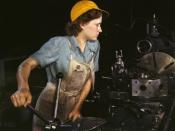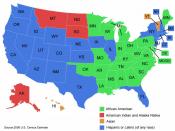The Australian workforce is defined as those people aged 15 years and over engaged in full-time or part-time employment and those officially recognized as being unemployed. Often the 'hidden unemployed' may not be included in such a definition. The hidden unemployed are the people who would work if there was a job available but for some reason, such as, disillusionment or discouragement, are not actively looking for employment. This usually occurs in times of high unemployment.
Since the development of communities, women's work revolved more around the home. They prepared food, made clothing, and cared for children, while also helping to plow fields, harvest crops, and tend animals. As cities developed, some women sold or traded goods in the marketplace.
It was thought that for a women to have a child, she would give up her right to a career of her choice, and instead stay home to look after the child and do housework.
Things have come along way since that time and women often choose to re-enter the workforce after having a child, this is where the discrimination starts.
Women continue to be paid less for their labour than men. In 2001 women's median annual full-time earnings were 28 percent less than men's earnings. Women in professional jobs earned 70 cents and saleswomen earned 60 cents for every dollar earned by their male counterparts. One reason for this inequality is that a relatively small number of women hold top-level jobs, even in such fields as social work, library work, and teaching, in which they greatly outnumber men. Even when they do the same kind of work at the same level, they are frequently paid less than men. Women are also more likely to work part time or to be unemployed. Women in minority groups remained the lowest paid,



Women!!!
Over the years there has beign reasonable improvement in the number of women in the work force,and this due clearly to the fact that people are waking up to the issue of gender inequality.
But that does not mean that women are not relegated to the background of lower paid jobs,or are not discriminated at, at wok plces and employment processesVery well this is a good issue,but the writer is very brief about this essay,its a nice work but needs to be developed fully.cheers!!
2 out of 2 people found this comment useful.